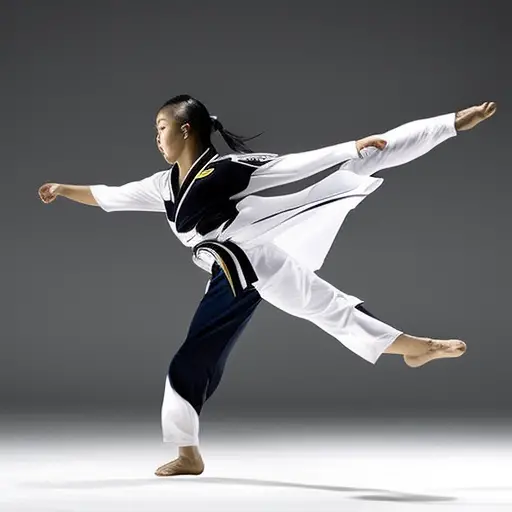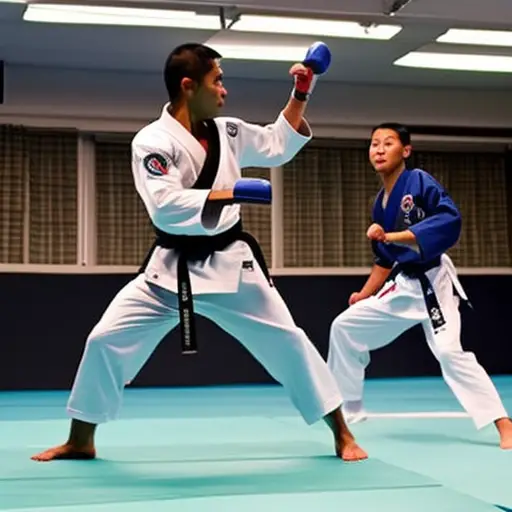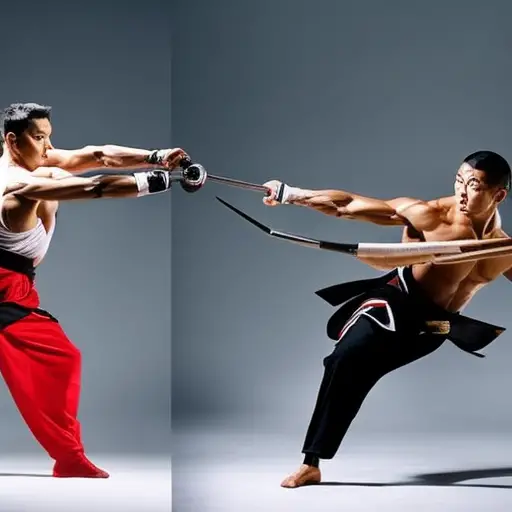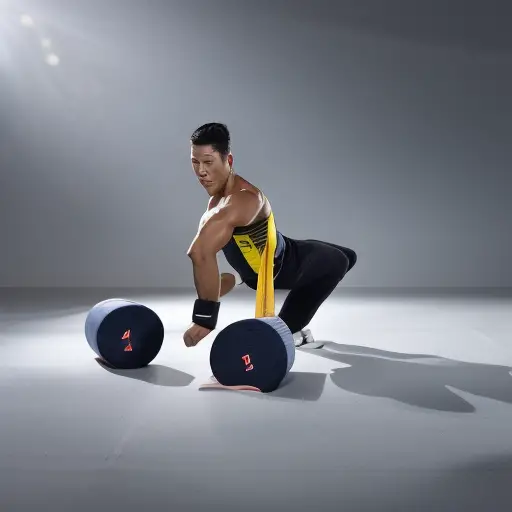Delving Into Taekwondo Footwork

Immerse yourself in the intricate dance of Taekwondo footwork, where every movement holds the potential for power and precision. Like a skilled tango between mind and body, Taekwondo footwork is an art that demands both finesse and technique.
In this article, we will delve into the secrets of mastering foot placement, balance, and agility, as we explore the various stances, movements, and drills that form the foundation of this dynamic martial art.
Prepare to step into a world of grace, control, and unwavering focus.
The Importance of Footwork in Taekwondo
One cannot overstate the significance of footwork in the practice of Taekwondo. The importance of agility and speed in Taekwondo footwork cannot be emphasized enough. Footwork is a crucial aspect of this martial art, as it allows practitioners to quickly move in and out of range, evade attacks, and launch counterattacks with precision.
Agility is essential in Taekwondo footwork because it enables practitioners to swiftly change direction, pivot, and maintain balance while executing various techniques. It allows them to evade opponents’ attacks and create openings for their own strikes. Moreover, speed is equally important as it enables practitioners to close the distance quickly and launch powerful attacks.
To improve agility and speed in Taekwondo footwork, practitioners often engage in footwork drills. These drills focus on improving reflexes and coordination, allowing practitioners to react quickly and accurately to their opponents’ movements. Examples of footwork drills include ladder drills, where practitioners move their feet in and out of ladder rungs, and cone drills, where they navigate around cones placed in various patterns. These drills enhance footwork skills, improve reaction time, and develop muscle memory, ultimately leading to more effective and efficient movement during combat.
Basic Stances and Positions in Taekwondo Footwork
As practitioners delve into the world of Taekwondo footwork, it is important to understand the basic stances and positions that form the foundation of this martial art. Mastering weight distribution and fluid transitions between stances is essential for effective movement and execution of techniques.
One of the fundamental stances in Taekwondo is the ‘Juchumseogi’ or ‘natural stance.’ In this stance, the feet are shoulder-width apart, with toes pointing forward and the body weight evenly distributed between both legs. It provides a stable base for initiating attacks or defending against opponents.
Another important stance is the ‘Apseogi’ or ‘front stance.’ In this position, one foot is positioned forward while the other foot forms a right angle with the back leg, creating a longer and narrower stance. This allows for greater reach and stability when executing powerful strikes.
Other stances include the ‘Dwitkubi’ or ‘back stance,’ the ‘Gunnunseogi’ or ‘sitting stance,’ and the ‘Seogi’ or ‘horse stance.’ Each stance has its own purpose and benefits, and practitioners must learn to transition smoothly between them to maintain balance and fluidity in their movements.
Mastering Balance and Stability in Taekwondo Footwork
When it comes to mastering balance and stability in Taekwondo footwork, precise steps are of utmost importance. By maintaining a firm and stable base, practitioners are able to execute techniques with greater accuracy and power.
Techniques such as weight distribution, core engagement, and proper alignment can greatly enhance balance and stability in Taekwondo footwork.
Importance of Precise Steps
Developing and refining precise footwork is crucial for achieving optimal balance and stability in the practice of Taekwondo. Precise steps play a vital role in sparring, as they allow practitioners to move swiftly and effectively, making it easier to evade attacks and launch counterattacks. In forms, precise footwork enhances the overall performance by showcasing control, precision, and grace. It is essential to understand the benefits of precise footwork in forms, as it not only improves the aesthetic appeal but also enhances the practitioner’s focus, discipline, and mental clarity.
To further emphasize the importance of precise steps, let’s take a look at the table below:
| Benefits of Precise Footwork in Forms | ||
|---|---|---|
| Enhances balance and stability | Improves body coordination | Promotes muscle memory |
| Increases flexibility and agility | Enhances overall performance | Boosts concentration |
| Strengthens lower body muscles | Develops control and precision | Fosters discipline |
| Improves mental clarity | Elevates aesthetic appeal | Enhances self-confidence |
Techniques for Maintaining Balance
Mastering balance and stability in Taekwondo footwork requires implementing effective techniques for maintaining equilibrium and control.
Techniques for improving agility and maintaining proper weight distribution are essential for achieving this balance.
One technique is to keep the body’s weight centered and evenly distributed between both feet. This ensures that the practitioner remains stable and grounded during movements.
Another technique is to engage the core muscles, as a strong core helps to maintain balance and stability.
Additionally, proper foot positioning is crucial. The feet should be aligned in the direction of movement, with the toes pointing forward. This allows for better control and stability.
Exploring Forward and Backward Movement Techniques
When it comes to taekwondo footwork, mastering the techniques of forward stepping is crucial. These techniques involve stepping forward with the lead foot while maintaining balance and stability.
Additionally, backward sliding methods are equally important for efficient movement in taekwondo. By sliding the back foot backward, practitioners can maintain a strong defensive position while preparing for counterattacks.
Forward Stepping Techniques
Forward stepping techniques in Taekwondo play a crucial role in enhancing agility and balance during combat situations. These techniques involve specific drills that focus on improving the practitioner’s ability to move forward swiftly and efficiently.
By practicing forward stepping drills, Taekwondo practitioners can develop the necessary footwork and body coordination to effectively close the distance between themselves and their opponents. This not only allows them to launch powerful attacks but also enables them to evade incoming strikes with ease.
The constant repetition of these drills builds muscle memory, enabling the practitioner to execute forward steps instinctively during sparring or real-life self-defense scenarios.
Moreover, enhancing agility through forward stepping techniques can give practitioners a psychological advantage, boosting their confidence and overall performance in Taekwondo.
Backward Sliding Methods
The proficiency of a Taekwondo practitioner in executing effective backward sliding methods is essential for maintaining defensive positioning while simultaneously creating opportunities for counterattacks. Backward sliding techniques involve moving away from an opponent while still maintaining balance and readiness to strike. These techniques require a combination of agility, coordination, and footwork speed improvement.
To illustrate the importance of backward sliding methods, let’s take a look at the following table:
| Technique | Description | Benefits |
|---|---|---|
| Backward Slide | Sliding step executed by pushing off the back leg and dragging the front foot backward. | – Creates distance from an opponent |
- Allows for quick evasive movements
- Sets up counterattacking opportunities |
| Reverse Slide | Similar to the backward slide, but executed with the opposite foot. | – Provides versatility in footwork - Confuses opponents with unpredictable movements
- Enables rapid changes in direction |
| Crab Walk | Sideways sliding motion with feet shoulder-width apart. | – Facilitates defensive positioning - Enhances lateral movement capabilities
- Maintains balance while retreating |
Efficient Footwork Strategies
Utilizing efficient footwork strategies in Taekwondo involves exploring both forward and backward movement techniques to enhance agility and create strategic advantages during combat. Mastering these techniques not only improves agility in Taekwondo but also allows practitioners to effectively evade attacks and swiftly counter-attack.
Here are some efficient footwork techniques that can greatly improve agility in Taekwondo:
-
Forward Lunge: This technique involves taking a large step forward while maintaining balance and control. It allows for quick advancement towards the opponent, setting up powerful offensive moves.
-
Backward Slide: This technique involves sliding the back foot backward while maintaining a stable stance. It enables practitioners to create distance from the opponent while keeping them within striking range.
-
Angle Step: This technique involves stepping to the side at an angle, allowing practitioners to create advantageous positions for attacking or avoiding attacks.
Sidestepping and Lateral Movement in Taekwondo Footwork
During taekwondo training, practitioners often incorporate sidestepping and lateral movement to enhance their agility and strategic positioning. Sidestepping techniques involve moving to the side while maintaining a balanced stance, allowing practitioners to evade attacks and create openings for counterattacks.
One common sidestepping technique used in taekwondo is the ‘step and slide’ method. This technique involves taking a small step to the side and then sliding the trailing foot to meet the leading foot, effectively shifting the practitioner’s position laterally. By practicing sidestepping techniques, taekwondo practitioners develop the ability to quickly and efficiently move laterally, enabling them to evade opponents’ attacks and create advantageous positions for offensive maneuvers.
Lateral movement drills are an essential part of taekwondo training, as they help improve footwork, balance, and coordination. These drills involve moving laterally along a line or in a designated area, focusing on proper weight distribution and maintaining a low center of gravity.
One common lateral movement drill is the ‘shuttle run.’ In this drill, practitioners move laterally back and forth between two designated points, emphasizing quick changes in direction and speed. This drill not only enhances agility but also improves reaction time, as practitioners learn to quickly adjust their movements based on their opponent’s actions.
Pivoting and Rotational Techniques for Effective Strikes
With precise footwork and mastery of pivoting and rotational techniques, taekwondo practitioners can enhance the power and accuracy of their strikes. Pivoting techniques involve the rotation of the supporting foot while the striking foot remains stationary, allowing the practitioner to generate maximum force and reach. By pivoting, a taekwondo practitioner can quickly change direction and angle, creating openings for strikes and avoiding counterattacks. This dynamic footwork technique requires balance, agility, and coordination.
Rotational strikes, on the other hand, involve the full rotation of the body, generating power through the hips and core muscles. By twisting the torso and shoulders, a taekwondo practitioner can deliver devastating strikes with great speed and force. This technique is particularly effective in generating power for kicks and punches.
When executed properly, pivoting and rotational techniques can have a significant impact on the effectiveness of strikes in taekwondo. Here are three emotional responses that these techniques can evoke:
- Excitement: Witnessing a taekwondo practitioner swiftly pivot and deliver a powerful strike can be thrilling, leaving the audience in awe of their skill and precision.
- Admiration: The mastery of pivoting and rotational techniques requires years of practice and dedication, earning the respect and admiration of fellow practitioners and spectators.
- Inspiration: Watching taekwondo practitioners execute flawless pivoting and rotational strikes can inspire others to pursue their own martial arts journey, encouraging them to strive for excellence and overcome challenges.
Utilizing Angles and Changes in Direction in Taekwondo Footwork
Employing strategic angles and swift changes in direction is crucial in maximizing the effectiveness of taekwondo footwork. By incorporating these elements, practitioners can enhance their agility and create opportunities for attacking or evading their opponents. To develop the necessary skills, taekwondo athletes can engage in various footwork drills that focus on angles and directional changes.
| Footwork Drill | Description |
|---|---|
| L-Step | Begin with feet shoulder-width apart. Step forward with the lead foot at a 45-degree angle, followed by the rear foot. Alternate the steps to move forward or backward. |
| Pivot Step | Start with feet shoulder-width apart. Pivot on the lead foot while keeping the rear foot stationary. Repeat the movement in the opposite direction. This drill helps with quick directional changes. |
| Zigzag Shuffle | Begin with feet hip-width apart. Shuffle to the right at a 45-degree angle, then quickly shuffle to the left at the same angle. Repeat the movement, creating a zigzag pattern. This drill improves lateral movement and agility. |
| Circle Footwork | Stand with feet shoulder-width apart. Move in a circular pattern by stepping forward, to the side, backward, and to the other side. This drill trains the body to smoothly transition between different angles and directions. |
Advanced Footwork Drills and Training Methods
How can taekwondo practitioners further enhance their footwork skills through advanced drills and training methods?
Advanced agility drills and speed and footwork exercises are essential for taking footwork skills to the next level. Here are three effective training methods that can evoke an emotional response in taekwondo practitioners:
-
Agility ladder drills: Performing agility ladder drills helps taekwondo practitioners improve their foot speed, coordination, and agility. These drills involve quick and precise foot movements through the ladder’s rungs, challenging the practitioner’s ability to maintain balance and control while moving rapidly. The sense of accomplishment and satisfaction that comes from successfully completing these drills can evoke a sense of pride and motivation.
-
Cone drills: Cone drills are versatile and can be customized to focus on specific footwork techniques, such as pivoting, side stepping, or explosive forward movements. By setting up a series of cones and performing various footwork patterns around them, taekwondo practitioners can enhance their speed, agility, and ability to change directions quickly. The challenge of executing these drills with precision and speed can evoke a sense of determination and drive.
-
Reactive agility drills: Reactive agility drills involve reacting to visual or auditory cues, simulating real-time scenarios that taekwondo practitioners may encounter during sparring or competitions. These drills improve reflexes, decision-making skills, and the ability to quickly adjust footwork based on the opponent’s movements. The thrill and excitement of reacting swiftly and accurately to these cues can evoke a sense of adrenaline and competitiveness.
Frequently Asked Questions
What Are Some Common Mistakes to Avoid in Taekwondo Footwork?
Common mistakes in taekwondo footwork can hinder performance and leave practitioners vulnerable. To avoid errors, focus on maintaining balance, proper weight distribution, precise timing, and executing techniques with fluidity.
How Can I Improve My Speed and Agility in Taekwondo Footwork?
To improve speed and agility in Taekwondo footwork, practitioners can employ various techniques and training drills. These methods focus on enhancing explosive movements, balance, coordination, and flexibility, ultimately leading to improved performance in the discipline.
Are There Any Specific Exercises or Stretches That Can Help With Taekwondo Footwork?
Exercises and stretches play a crucial role in enhancing taekwondo footwork. They can improve agility, balance, and flexibility, enabling practitioners to execute swift and precise movements. Incorporating specific exercises and stretches tailored to taekwondo footwork can yield significant improvements.
What Are Some Tips for Maintaining Proper Posture and Alignment During Taekwondo Footwork?
Maintaining proper posture and alignment during taekwondo footwork is crucial for balance, flexibility, and coordination. Tips include keeping the back straight, engaging the core muscles, and focusing on distributing weight evenly between the feet.
How Can I Incorporate Footwork Into My Sparring or Competition Strategy in Taekwondo?
Incorporating footwork into sparring and competition strategy in Taekwondo requires methods for analyzing and strategizing. Footwork plays a vital role in Taekwondo competition, and developing it is crucial for success.
Conclusion
In conclusion, footwork is a crucial aspect of taekwondo training. It enhances balance and stability and enables effective movement and striking techniques. By mastering various footwork techniques, taekwondo practitioners can improve their overall performance in the sport.
For example, imagine a taekwondo athlete executing a perfectly timed sidestep to dodge an opponent’s attack and counter with a powerful kick. This display of agility and skill leaves the audience in awe.
By incorporating forward and backward movement, sidestepping, pivoting, and utilizing angles, taekwondo practitioners can enhance their footwork skills. These techniques allow for improved agility, quick reflexes, and the ability to create openings for attacks.
In summary, footwork is a fundamental aspect of taekwondo that should not be overlooked. It is essential for maintaining balance, executing techniques effectively, and outmaneuvering opponents. With dedicated practice and focus on footwork, taekwondo practitioners can elevate their performance and excel in the sport.





